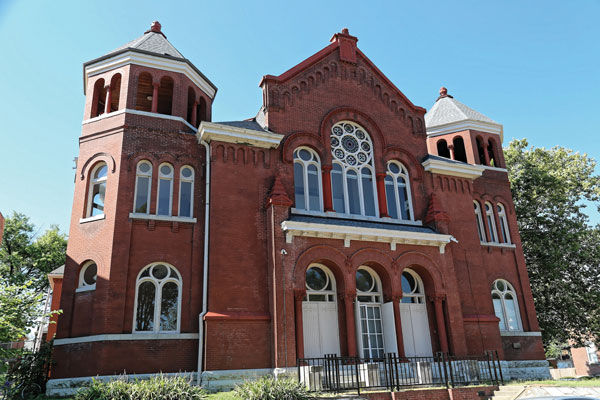10 architecturally significant St. Louis synagogues
Published October 14, 2015
Following is a list of 10 local synagogues that represent significant architectural works. The first eight also embody the spirit of adaptive reuse. Three (Bais Abraham, CRC and Kol Rinah) are still active synagogues.
Bais Abraham
6910 Delmar Boulevard
ADVERTISEMENT
Formerly: Tpheris Israel Chevra Kadisha
Built: 1920s
Architect: Unknown
Style: Classical
Notable design elements:Prominent stone façade and impressive stained glass allowing natural light into sanctuary.
Kol Rinah
829 N. Hanley Road
Formerly: Shaare Zedek
Built: 1950
Architect: Bernard Bloom
Style: Mid-century Modern
Notable design elements: The streamlined, rounded corners and large front-facing representation of the Torah are the most prominent design elements.
Washington University
560 Music Center
560 Trinity Avenue
Formerly: Shaare Emeth
Built: 1930
Architect: Unknown
Style: Art deco
Notable design elements: Prominent bas-relief imagery and “SHAARE EMETH” on façade facing Delmar Boulevard, with imposing brick and stonework.
Center of Contemporary Arts (COCA)
524 Trinity Avenue
Formerly: B’nai Amoona Congregation
Built: 1950
Architect: Eric Mendelsohn
Style: Mid-century Modern
Notable design elements: The building has 12 windows in the sanctuary, which may suggest Mendelsohn created a numerical reference to the 12 tribes of Israel.
Angelic Temple of Deliverance
5001 Washington Boulevard
Formerly: Temple Israel
Built: 1907
Architect: Barnett, Haynes & Barnett
Style: Corinthian Neoclassical
Notable design elements: Corinthian columns made of Caen stone give the building a serious-looking, judicial appearance.
Missouri History Museum and Research Center
225 S. Skinker Boulevard
Formerly: United Hebrew Congregation
Built: 1927
Architect: Maritz and Young, with consulting architect Gabriel Ferrand
Style: Byzantine
Notable design elements: The 82-foot diameter dome in the reading room (previously sanctuary) was inspired by the Hagia Sophia in Istanbul. At the time of its dedication, UH was one of the three largest synagogues in the country.
Temple Apartments
3666 Flad Avenue
Formerly: B’nai El (1905-1944)
Built: Dedicated in 1906
Architect: John L. Wees
Style: Romanesque Revival
Notable design elements: The building’s Romanesque and Byzantine architecture make it stand out in this residential neighborhood just west of the Compton Hill Water Tower. Although it’s now an apartment building, one look at the outside immediately tells you it was at one time a religious building.
Pleasant Green Missionary Baptist Church
4570 Page Boulevard
Formerly: Shaare Zedek
Built: 1913
Architect: Unknown
Style: Classical
Notable design elements: large, semicircular gables and large lunettes with glazed opalescent glass Star of David.
The following are much newer, but are significant architectural works—designed by a founding member of CRC (Andy Trivers), and in the case of UH, the final design of important American architect Pietro Belluschi.
Central Reform Congregation
5020 Waterman Avenue
Built: 2000
Architect: Andy Trivers
Style: Modern
ADVERTISEMENT
Notable design elements: When members walk in the entrance, they encounter the oneg area, a gathering place. This was a deliberate design strategy, because the philosophy of the congregation is all about community.
United Hebrew Congregation
13788 Conway Road
Built: 1990
Architect: Pietro Belluschi
Style: Modernist
Notable design elements: The exterior arch on the east side of the sanctuary and the series of three vertical windows mirror the same components of the former UH building (now Missouri History Museum Library) on Skinker Boulevard.

















